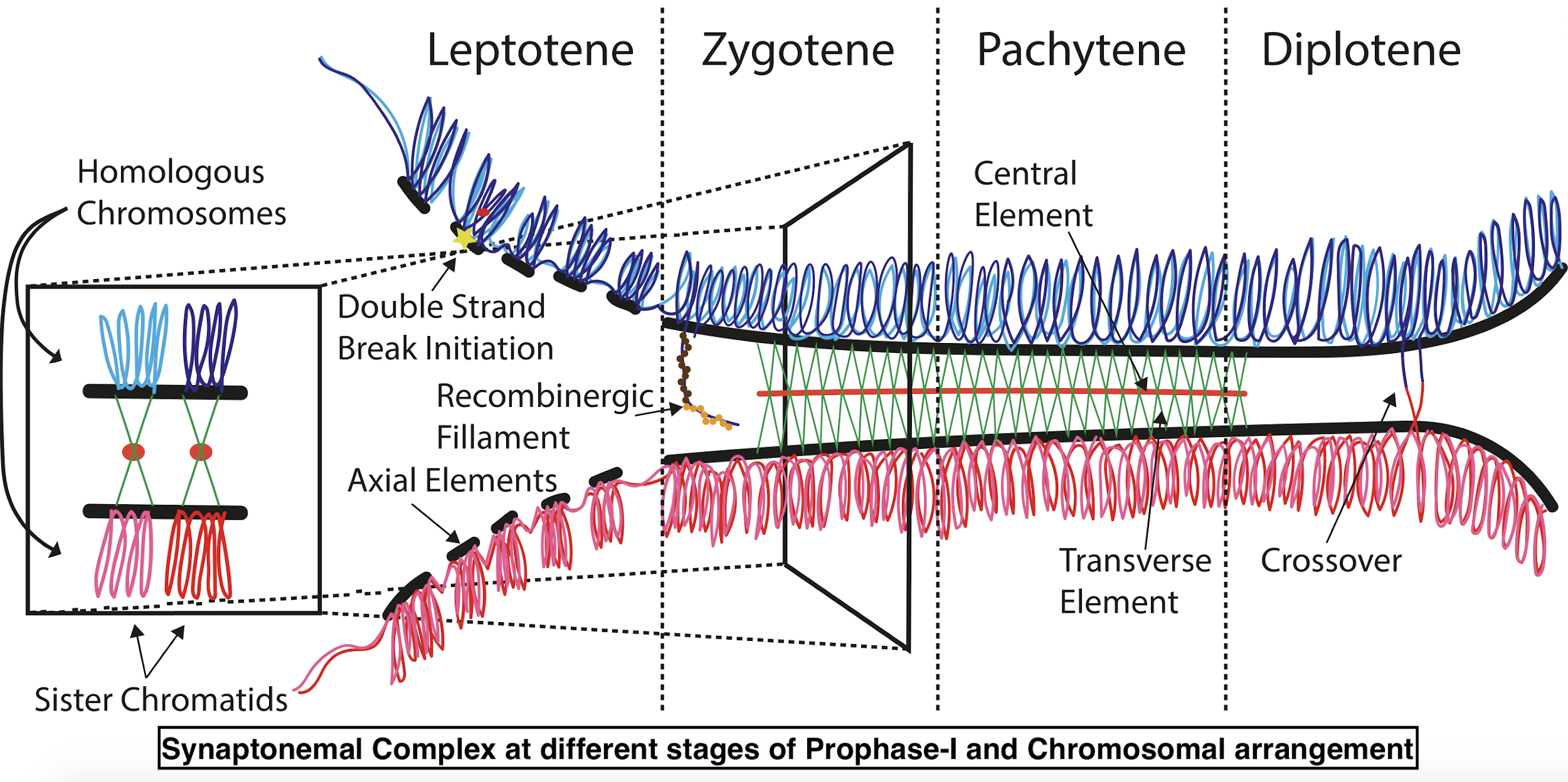
In a cell cycle crossing over occurs at
(a) Single strand stage
(b) Two strand stage
(c) Four strand stage
(d) Eight strand stage
Answer
564.6k+ views
Hint: Crossing over is the mutual exchange and reciprocal recombination of chromatid segments, DNA fragments, or block of genes between the non-sister chromatids of homologous chromosomes. Crossing over occurs during prophase I of meiosis before tetrads are aligned along the equator in metaphase I. Only two of the four chromatids are involved in Crossing over.
Complete answer:
In a cell cycle, crossing over occurs at the four-strand stage. Crossing over involves the symmetrical breakage of chromatids, and the reciprocal exchange and crosswise reunion of segments between non-sister chromatids, often breaking linkage. This results in the recombination of genes. Crossing over occurs at the pachytene stage of prophase I of Meiosis I.

During the pachytene, stage one chromatid of each homologue overlaps or crosses over a corresponding non-sister chromatid of the other homologue at one or more points. These crossing points are called chiasma. At this point, the non-sister chromatids divide transversely with the help of endonuclease. The broken segments are then mutually exchanged by them. Each exchanged segment fuses with a corresponding portion of non-sister chromatids with the help of ligases. The whole process which involves the breakage, mutual exchange, and reciprocal reunion of chromosome segments is called crossing over.
Additional Information:
- Crossing over and the independent assortment of alleles are the major mechanisms for producing new, non-parental gene combinations and genetic variations.
- Natural selection acts upon these recombinant genotypes and genetic variations and thereby enhances the fitness, survival value, and evolutionary potentiality of organisms.
- In eukaryotes, crossing over may be mitotic or meiotic. Mitotic crossing over occurs in somatic cells and finial cells.
So, the correct answer is the '(c) four-strand stage’.
Note:
- Mitotic crossing over involves five major events; synapsis of homologous chromosomes and tetrad formation, crossing over of non-sister chromatids and chiasma formation, symmetrical breakage of non-sister chromatids, reciprocal recombination through the mutual exchange and crosswise reunion of broken segments, dissociation of the homologues by the decriminalization of chiasma.
- Synapsis is the close pairing of homologous chromosomes during the zygotene stage of the first meiotic division.
- Double-crossing over is the crossing over which involves two chiasma, two, three, or four chromatids.
Complete answer:
In a cell cycle, crossing over occurs at the four-strand stage. Crossing over involves the symmetrical breakage of chromatids, and the reciprocal exchange and crosswise reunion of segments between non-sister chromatids, often breaking linkage. This results in the recombination of genes. Crossing over occurs at the pachytene stage of prophase I of Meiosis I.

During the pachytene, stage one chromatid of each homologue overlaps or crosses over a corresponding non-sister chromatid of the other homologue at one or more points. These crossing points are called chiasma. At this point, the non-sister chromatids divide transversely with the help of endonuclease. The broken segments are then mutually exchanged by them. Each exchanged segment fuses with a corresponding portion of non-sister chromatids with the help of ligases. The whole process which involves the breakage, mutual exchange, and reciprocal reunion of chromosome segments is called crossing over.
Additional Information:
- Crossing over and the independent assortment of alleles are the major mechanisms for producing new, non-parental gene combinations and genetic variations.
- Natural selection acts upon these recombinant genotypes and genetic variations and thereby enhances the fitness, survival value, and evolutionary potentiality of organisms.
- In eukaryotes, crossing over may be mitotic or meiotic. Mitotic crossing over occurs in somatic cells and finial cells.
So, the correct answer is the '(c) four-strand stage’.
Note:
- Mitotic crossing over involves five major events; synapsis of homologous chromosomes and tetrad formation, crossing over of non-sister chromatids and chiasma formation, symmetrical breakage of non-sister chromatids, reciprocal recombination through the mutual exchange and crosswise reunion of broken segments, dissociation of the homologues by the decriminalization of chiasma.
- Synapsis is the close pairing of homologous chromosomes during the zygotene stage of the first meiotic division.
- Double-crossing over is the crossing over which involves two chiasma, two, three, or four chromatids.
Recently Updated Pages
Master Class 11 Business Studies: Engaging Questions & Answers for Success

Master Class 11 English: Engaging Questions & Answers for Success

Master Class 11 Computer Science: Engaging Questions & Answers for Success

Master Class 11 Social Science: Engaging Questions & Answers for Success

Master Class 11 Maths: Engaging Questions & Answers for Success

Master Class 11 Biology: Engaging Questions & Answers for Success

Trending doubts
One Metric ton is equal to kg A 10000 B 1000 C 100 class 11 physics CBSE

Explain zero factorial class 11 maths CBSE

An example of chemosynthetic bacteria is A E coli B class 11 biology CBSE

State the laws of reflection of light

Name the metals and nonmetals in the first twenty class 11 chemistry CBSE

What is 1s 2s 2p 3s 3p class 11 chemistry CBSE




